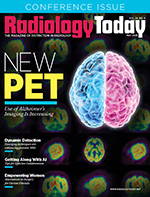 Editor’s Note: Incremental Gains
Editor’s Note: Incremental Gains
By David Yeager
Radiology Today
Vol. 26 No. 4 P. 4
Progress is rarely measured in leaps and bounds. More commonly, it’s the result of many small steps. Put one foot in front of the other long enough, and you’ll eventually be surprised by how far you’ve traveled. Many of the articles in this issue engender that scenario. Physicians and researchers work every day to advance medicine. The results are rarely immediate, but over time, they can make a notable difference in the lives of patients.
This month’s cover feature looks at advances in Alzheimer’s disease imaging. As the number of people with Alzheimer’s and other forms of dementia continues to grow, identifying people who are in the early stages is increasingly important. Researchers have identified biomarkers on PET imaging—amyloid and tau proteins—that help predict Alzheimer’s, and medications that slow Alzheimer’s progression can improve the quality of life for many people and their families. In late 2024, the SNMMI updated its appropriate use criteria to help guide physicians in their use of PET for amyloid and tau imaging. Beth W. Orenstein reports on the new guidelines, as well as advances in new radiotracers.
Also in this issue, Keith Loria has an update on advances in MR imaging for prostate cancer. As with many other areas of medical imaging, AI algorithms are helping radiologists identify imaging features with greater precision. Although there are limitations and challenges, researchers believe there is significant potential for MRI and AI to improve the accuracy of prostate imaging, especially in conjunction with other technologies such as PET and radiomics.
How AI should and shouldn’t help radiologists is a question that more people are asking. In weighing what humans do well against what AI does well, it would be natural to assume that they should simply work together, but the interaction is more complex than that. It turns out that data bias is not the only kind that humans need to account for; they also need to consider their own biases. Orenstein examines this emerging dynamic.
In IR news, Rebecca Montz takes a look at the use of uterine artery embolization (UAE) for uterine fibroids. Although UAE has proven to be an effective treatment, it is significantly underutilized. Some of the reasons for its underutilization are surprising, others less so, but experts agree that it can be an effective option for a greater number of women. For more details, turn to page 22.
Finally, a recent article in JAMA Internal Medicine found that CT scans may account for 5% of new cancer cases each year. As you can probably guess, it drew swift reactions from various medical associations. See page 5 for more on the study and subsequent responses.
Enjoy the issue.
— Dave Yeager
david.yeager@gvpub.com

